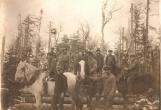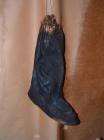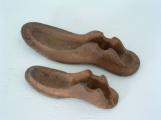1
In Birchy Bay's early days the lobsters were very plentiful. Many of the young children would catch lobsters in kelp beds in the bay and boil them up in the beach during long summer days. The lobster fishery meant a new source of work for the early settlers of Birchy Bay.They would knit lobster heads which was the mesh that the lobster travelled up to get inside the trap. They would cut lathes and get benders of fir to make the form of the trap. Most men would be able to make about a hundred traps a winter. In the bottom of these traps they placed flat stones which provided ballast to the trap.
In the spring just after the ice had moved out the bay the men would begin lobster fishing. Even the young boys would help out by spearing and catching flat fish and other bait at their fathers wharf heads. The men would put out nets to catch fish for bait. This would be the bait needed to lure the lobster into the lobster trap. The men painted up their wooden bobbers each man having a different colour to know his own traps.
The men would check their lobster traps daily. They used a metal guide to choose mature lobster to ensure a good stock for the next season. The lobsters would be out into wooden cages until either sold or canned. This provided a good source of income to the early families of Birchy Bay.
Due to the abundance of lobster, lobster canning became one of the first commercial industry in Birchy Bay.. In 1891 two lobster canneries were operating seasonally. Then in 1911 with a population of 127 people there were four lobster factories in operation. But with the onset of the logging industry the lobster fishery subsided for a period of time.
Today there are several people in Baytona who lobster fish, keeping the tradition alive. As they travel out the bay they pass by the factory rocks, the name which is a testament to the lobster factory. It was stationed there at the turn of the last century.
3
The Furrier's PathBirchy Bay like many other of the communities in Notre Dame Bay were first temporary settlements. Most of the people who came to settle there would leave again in view of the seasons. In the shelter of the bay there were more resources for these people to use.
According to tradition as told by Stanley Canning Sr. the first man to trap In Birchy Bay was John Canning. He would travel from Newstead to trap the watershed area of Jumpers Brook. Although it does appear that he lived there as well on Cannings Island. John would travel by a path known today as the furriers trail up Jumpers brook attending to his snares and traps. He would then travel down Jumper pond which is well known for its beaver and muskrats. Then he would portage across a neck of land out over to the salt water. It was later used by the Birchy Bay Lumber Company to harvest logs.
According to this tradition when John Canning of Barr'd Islands came to settle in Birchy Bay permanently he trapped with his relative John Canning of Newstead. The Canning Family from Newstead and the Canning Family from Birchy Bay trapped together for years. Then finally Andrew Canning came in possesion of the fur catching monopoly. In a diary kept by Stanley Canning it tells how Stanley's father from Birchy Bay skinned a fur bearing animal was with John Canning of Newstead at Barr'd Island.
4
Interview with Simon OsbourneQ: Why do you think people came here in Birchy Bay?
A: Good question, I guess because of the woods and the rabbits. My grandfather and father used to bottle rabbits.
Q: Where would sell the rabbits to?
A: You would sell them from the slip as we called it. Me and skipper west used to sell them to St. John's. We would ship them in on a train back then, that was our only transportation.
Q: How would you get up the country? Did you use a horse or walk?
A: No, we would go up in a train to lewisporte.
Q: How much would you get for a rabbit?
A: That's a good question, I haven't thought about that in a long time. I don't know. Hummmm.....I believe it was thirty-five cents a pair.
6
The seal has been used since prehistoric times by the earliest inhabitants of this province. The Maritime Archaic people and the Paleo Eskimos developed special tools which were used primarily for the harvest of seal. Not only was Seal meat a good source of fresh meat which contained Omega 3 unsaturated fatty acid. Its hide could be used to make clothing. The native people utilized this important asset of the seal which ensured their survival.7
The early settlers of our province may have learned the precious ways of preserving hide from native groups. The early settlers used sealskin to manufacture boots which they wore during the cold winters. The sealskin was extremely warm and worn inside rubber boots on occasion. They were able to keep feet warm and dry. Inside the boots were worn a few pairs of socks or "vamps" to help as an insulation.The seal skin takes long hours of work to make a good piece of leather. The hide was first either taken from a seal which was shot or purchased. The residents of Birchy Bay use to purchase seal skin from the New World Island and Twillingate region. The two principle producers of seal skin leather were Andrew Canning and Arthur Osmond. Andrew would often times purchase a great amount of seal skin to make leather enough not only for himself but to make boots to sell. They also sold hide to others who wished to make seal leather products.
9
To tan hide,the skin was scraped and all of the fat was removed to help aid in curing. Then the hide of the seal was placed in Jumpers Brook and rocks were placed on them and moved around at various times to allow the fat to wash off the pelt.This would help hair to loosen from its roots. After that the hair was scrapped from the pelt along with another good scrapping of the fat. The skin was then laced into a drying board and put out to dry. A mixture of Gillets lye was used to wash the pelts to give them a nice white colour. People can remember when Andrew Canning's fence was lined with the white skins drying. The skin was then prepared to put into salt water. But before doing so the men would in the spring of the year cut from the trees bark. Traditionally the barks would have been used to help cover yaffles or faggots of cured fish from the rain. Afterwards it would be pounded and broken into small pieces then salt water was added to this.The pelts were kept there until they were barked with a nice dark rusty brown. The pelts were then removed and stretched on a frame again and dried and the leather process was complete.Then came the making of the skin boots. The hide was cut into the shape that it was needed for the boots. Before sewing the men would chew the hide with their teeth to soften and moisten the skin to allow the awl and needle to pass through with sinew that they used to sew the skin with. The boots would be sewn with the aid of a mould which would help the sewer judge the size which was needed and to help with the turning of the boots. After the boots was all sewn they had to be turned and pleated. This procedure ensured that the boots were waterproof as well as fashionable. Many times the men would use cow hide for to make taps which would last much longer then seal skin.
10
Edgar Osmond and Jessie Osmond-Tanning Seal SkinSummer 2007
Birchy Bay, Newfoundland & Labrador, Canada
 Credits:
Credits:Mr & Mrs. Edgar Osmond
12
The ability to produce seal skin boots was a tradition passed on from generation to generation.13
Logging At Jumpers Brook-Bay of Exploits20th Century
Jumpers brook, Bay of Exploits, Newfoundland & Labrador, Canada




